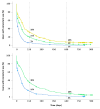The Long-Term Uptake of Home Spirometry in Regular Cystic Fibrosis Care: Retrospective Multicenter Observational Study
- PMID: 39788554
- PMCID: PMC11757947
- DOI: 10.2196/60689
The Long-Term Uptake of Home Spirometry in Regular Cystic Fibrosis Care: Retrospective Multicenter Observational Study
Abstract
Background: Home spirometers have been widely implemented in the treatment of people with cystic fibrosis (CF). Frequent spirometry measurements at home could lead to earlier detection of exacerbations. However, previous research indicates that the long-term use of home spirometry is not well maintained by people with CF.
Objective: We aimed to gain insight into the long-term uptake of home spirometry in regular multicenter CF care.
Methods: Home spirometers combined with a remote monitoring platform were introduced in the treatment of people with CF in 5 Dutch CF centers starting in April 2020. Usage data from April 2020 to December 2022 were analyzed retrospectively. Survival analyses were conducted to assess use consistency over time, and t tests were used to evaluate the impact of increased pulmonary symptoms on home spirometry frequency. The effect of the initiation of a new treatment, Elexacaftor/Tezacaftor/Ivacaftor, on use frequency over time was assessed in a subgroup of participants with repeated measures ANOVA.
Results: During the observation period, a total of 604 people with CF were enrolled in the remote monitoring platform and 9930 home spirometry measurements were performed. After the initiation of home spirometry use, the number of users declined rapidly. One year after the initiation, 232 (54.2%) people with CF stopped using home spirometry. During the observation period, 67 (11.1%) users performed more than 20 measurements. Furthermore, the number of consistent home spirometry users decreased over time. After 600 days, only 1% of users had measured their lung function consistently every 31 days. Use frequency slightly increased during periods with increased pulmonary symptoms (ΔMean=0.45, t497.278=-4,197; P<.001) and showed an initial rise followed by a decrease after starting treatment with Elexacaftor/Tezacaftor/Ivacaftor (ΔMean=0.45, t497.278=-4,197; P<.001).
Conclusions: Consistent uptake of home spirometry in people with CF is low but increases around periods of changing symptoms. A clear strategy for the organization of remote care seemed to improve the long-term uptake of home spirometry. Nevertheless, home spirometry and its intensity are not a goal on their own but should be used as a tool to reach individual goals within local contexts.
Keywords: adherence; autosomal disease; cystic fibrosis; digital health; eHealth; frequency; home spirometers; pulmonary medicine; remote monitoring; spirometry; survival analyses; telehealth; telemonitoring; treatment.
©Pia Bertram, Martinus C Oppelaar, Michiel AGE Bannier, Monique HE Reijers, Hester van der Vaart, Renske van der Meer, Josje Altenburg, Lennart Conemans, Bart L Rottier, Marianne Nuijsink, Lara S van den Wijngaart, Peter JFM Merkus, Jolt Roukema. Originally published in the Journal of Medical Internet Research (https://www.jmir.org), 09.01.2025.
Conflict of interest statement
Conflicts of Interest: MO, LvdW, JR, and PM are involved in the development of the software used in this study. The software is the property of the Radboud University Medical Center and hence does not generate any profits for the authors.
Figures


References
-
- Ratjen F, Bell SC, Rowe SM, Goss CH, Quittner AL, Bush A. Cystic fibrosis. Nat Rev Dis Primers. 2015 May 14;1(1):15010. doi: 10.1038/nrdp.2015.10. https://europepmc.org/abstract/MED/27189798 nrdp201510 - DOI - PMC - PubMed
-
- Bell Sc, Mall Ma, Gutierrez H, Macek M, Madge S, Davies Jc, Burgel P, Tullis E, Castaños C, Castellani C, Byrnes Ca, Cathcart F, Chotirmall Sh, Cosgriff R, Eichler I, Fajac I, Goss Ch, Drevinek P, Farrell Pm, Gravelle Am, Havermans T, Mayer-Hamblett N, Kashirskaya N, Kerem E, Mathew Jl, McKone Ef, Naehrlich L, Nasr Sz, Oates Gr, O'Neill C, Pypops U, Raraigh Ks, Rowe Sm, Southern Kw, Sivam S, Stephenson Al, Zampoli M, Ratjen F. The future of cystic fibrosis care: a global perspective. The Lancet Respiratory Medicine. 2020 Jan;8(1):65–124. doi: 10.1016/S2213-2600(19)30337-6.S2213-2600(19)30408-4 - DOI - PMC - PubMed
-
- Castellani C, Duff AJA, Bell SC, Heijerman HGM, Munck A, Ratjen F, Sermet-Gaudelus I, Southern KW, Barben J, Flume PA, Hodková P, Kashirskaya N, Kirszenbaum MN, Madge S, Oxley H, Plant B, Schwarzenberg SJ, Smyth AR, Taccetti G, Wagner TO, Wolfe SP, Drevinek P. ECFS best practice guidelines: the 2018 revision. J Cyst Fibros. 2018;17(2):153–178. doi: 10.1016/j.jcf.2018.02.006. https://linkinghub.elsevier.com/retrieve/pii/S1569-1993(18)30029-8 S1569-1993(18)30029-8 - DOI - PubMed
-
- Dowd C, Van Citters AD, Dieni O, Willis A, Powell L, Sabadosa KA. Design and methods for understanding the state of cystic fibrosis care amid the COVID-19 pandemic. J Cyst Fibros. 2021;20 Suppl 3:3–8. doi: 10.1016/j.jcf.2021.08.028. https://linkinghub.elsevier.com/retrieve/pii/S1569-1993(21)01369-2 S1569-1993(21)01369-2 - DOI - PMC - PubMed
-
- Richardson CH, Orr NJ, Ollosson SL, Irving SJ, Balfour-Lynn IM, Carr SB. Initiating home spirometry for children during the COVID-19 pandemic - a practical guide. Paediatr Respir Rev. 2022 Jun;42:43–48. doi: 10.1016/j.prrv.2021.02.001. https://europepmc.org/abstract/MED/33773928 S1526-0542(21)00004-X - DOI - PMC - PubMed
Publication types
MeSH terms
LinkOut - more resources
Full Text Sources
Medical
Miscellaneous

